Motorcycle Investor mag
Subscribe to our free email news

Fast by Design
(by Guy ‘Guido’ Allen, pics by Ellen Dewar, December 2020)
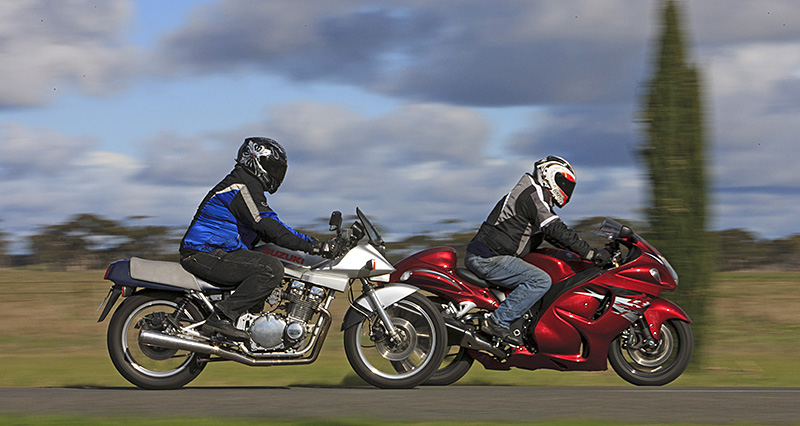
1981 Suzuki Katana vs 2011 Suzuki Hayabusa
There have been times when Suzuki has given subtlety the flick and gone for good old fashioned muscle, wrapped in stylish clothes. Some time ago, we put these two iconic models side-by side to see what difference was made by three decades of development
It’s sometimes difficult to hear yourself think over the shriek of rival performance claims from assorted manufacturers as they tout the virtues of their latest transport of delight. So, has it always been like this? Yup, pretty much.
But even amidst the carnival-like bustle for attention, some models manage to pop their proverbial heads above the crowd. Two from Suzuki have been the Katana and, three decades later, the Hayabusa. Let’s take them for a spin around the block.
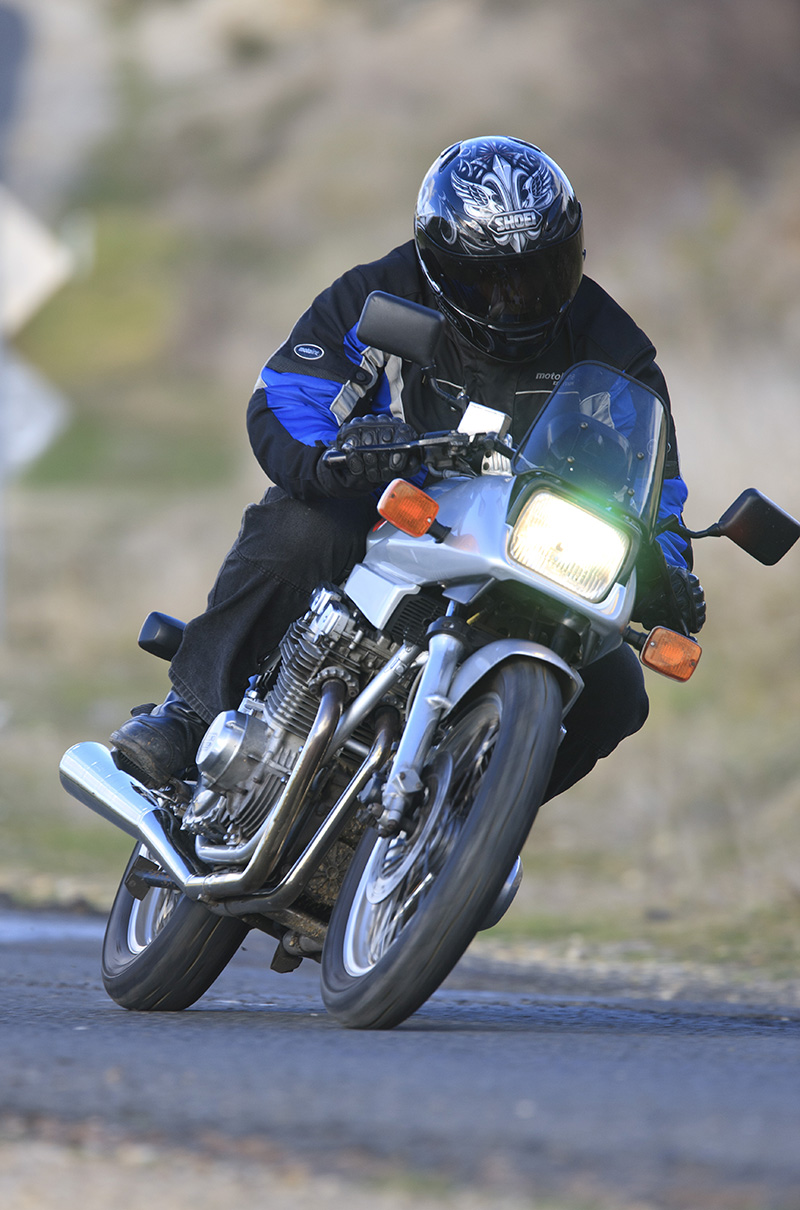
German Kats
You have to step back to 1980 or there-abouts and take a virtual tour of the motorcycle showroom of the day to fully understand the significance of the Katana. Motorcycles with fully integrated or themed bodywork were certainly around but were thin on the ground.
Full-dress tourers had fairings, as did some machinery at the more sporting end of the scale, such as Ducati’s SS series or Suzuki’s own GS1000S Wes Cooley replica. The vast majority of tackle was naked. And the idea of actually sending something off to a professional design house was unthinkable – that was something car companies did.
Then someone at Suzuki got the bright idea of letting German firm Target Design, run by Hans A Muth, Hans Georg Kasten and Jan Olof Fellström, loose on the GSX1100. They sketched up something that looked fairly wild even by current standards, and was subsequently refined with the aid of a wind tunnel. Even once it reached production form, the Katana (named after a Samurai blade) was a radical-looking bit of gear.
Launched in September 1981 for the 1982 model year, the GSX100SZ caused quite a stir. Ironically, where its more bluff and traditional-looking GSX1100E naked predecessor enjoyed considerable racetrack success, the Katana had trouble matching it. In just one or two years, the competition had become a whole lot more fierce.
Underneath the bodywork, the mechanical package was near identical to the ‘plain’ GSX1100. An exception was the bike you see here, which is the GSX1100SXZ, which was the 'production race' version. The big (and only) difference was the wire-spoked wheels (later retro-fitted to a lot of Katanas) which were the preferred gear on other actual race-oriented variants, while the mechanical distinction was nil in Australia. A stocker claimed 111 horses.
The mechanical package was a familiar one by this stage: an inline air-cooled four with CV carbs, 16 valves, and a five-speed transmission. While the power number is hardly riveting by today’s standards, it was enough to propel the 230-odd kilo lump (more like 250 when fuelled and on the road) to around 230km/h.
Under the bodywork, the chassis was very conventional. Front suspension was fitted with anti-dive units (removed from the bike you see here) plus preload and compression damping adjustment, while the rear had twin shocks with the same adjustment set as the front.
The angular and modernist design was carried through to a host of details, including switchgear and a prominent choke mechanism integrated into the sidecovers, plus an instrument cluster unique to that model.
And the ride? The seating position is long and rangy, and really only starts to work once you get it up to highway speeds or better. Steering is ponderous and it definitely rewards a plan-ahead and committed approach to riding. You can forget last-second flitting changes of line – this is definitely in the dinosaur school of motorcycle handling. Desperate braking maneuvers are out, too.
That said, it’s fun. The engine is responsive, the transmission surprisingly slick, and it does have that ‘on rails’ feel through a set of sweepers.
One thing you can say for these old things is they’re fast and robust. Once sorted (spares access is pretty good), they’re a very low-stress classic.
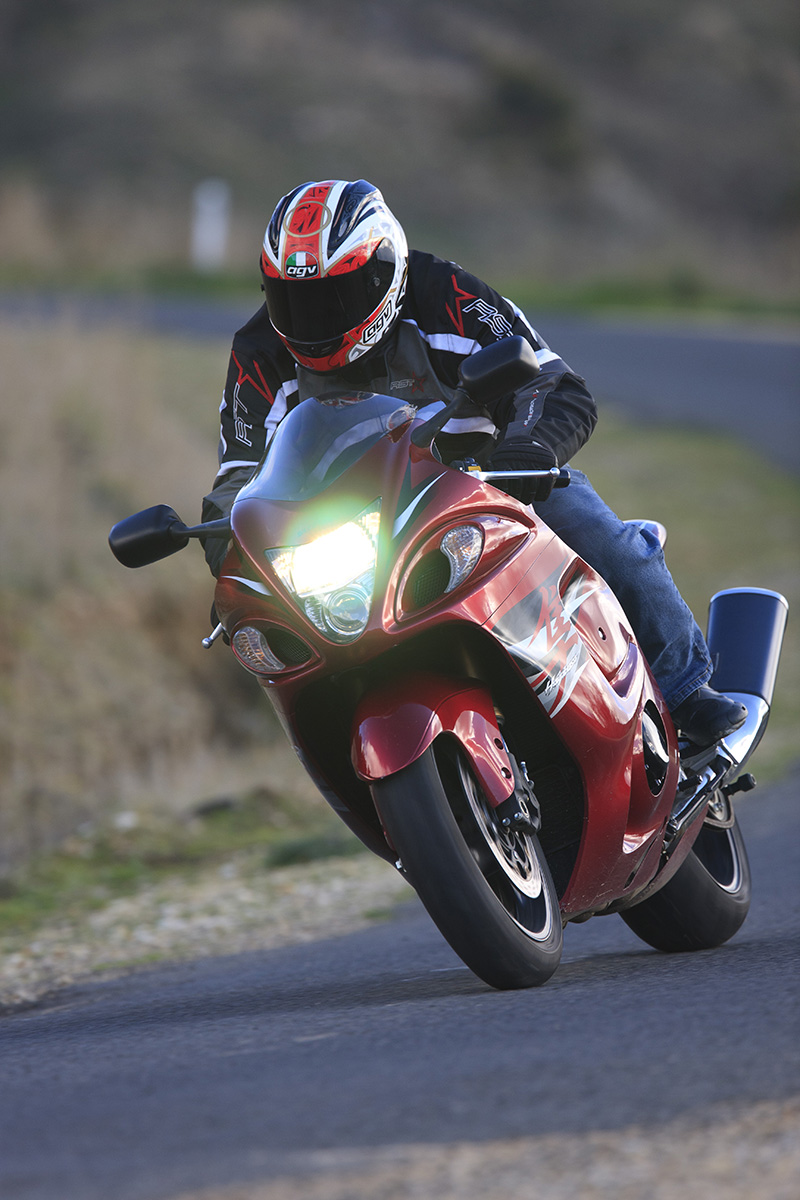
Give ’em the bird
When Suzuki first launched the Hayabusa, in 1999, the very name was a little corporate joke. If we step back a little, three years before, Honda had launched the Blackbird – the name was referring to the high-altitude USA spyplane, aka the Lockheed SR-71. The motorcycle version was also fast and stealthy, capable of 280km/h.
Suzuki replied with the Hayabusa, which in the bird world is a falcon (or bird of prey) that includes feathered blackbirds in its diet. While it was a cheeky move, it was anything but the first ‘theme’ bike from the Hamamatsu factory.
Like the Katana, it was developed with a lot of wind tunnel time – to the point where the designers exceeded their target 300km/h top speed. That was enough to make the Hayabusa an instant headline and send it on its way to cult bike status.
The dramatic curves of the first edition were the work of designer Koji Yoshiura, who told Autoevolution online in 1999, "We showed the head of marketing the final clay prototype, and he was stunned. Totally speechless! He didn't know what to say, which is a little like the reaction we got at the Paris show. The bike was a bit polarising – people didn't know quite what to think of it." Yoshiura revisited his bold lines to produce the second-generation bike.
The first model ran from 1999 to 2007 with minimal changes other than paint. A significant exception was a 2004 switch to a more sophisticated 64-bit processor for the engine control unit, which gave a modest lift in power and marginally better throttle response.
We saw the second-gen (shown here) introduced in 2008, with mixed responses from ’Busa fans. The styling was criticized by some hard-core ’Busa nuts, though I think time has softened the attitude of many – it’s different but very much in the spirit of the original.
The mechanical package has always been an injected inline four with 16 valves, mated to a six-speed transmission. Meanwhile the chassis is conventional for its time, with a twin-spar alloy frame matched to USD front fork and a monoshock rear with full adjustment at both ends.
Underneath the bodywork, generation two is a much-improved motorcycle. Suspension was upgraded, as were the brakes. Though moving from six-piston fronts to four, they offer more power and much better feel. Also, we got a lift in engine capacity (up from 1298cc to 1340) along with a jump from a claimed 175 horses to 194.
As a package, the current bike really is a delight to ride. It’s undemanding, and will happily mix it in peak-hour or stretch its very long legs on the open road.
Steering is light for something this capacity and, from the saddle, it doesn’t feel like a particularly big motorcycle. Suspension and braking are both of a high standard, though an ABS option is sorely missed. (That was introduced in 2013.)
30 years better?
So how far did we get in three decades? If you step back and look at the two spec sheets for these motorcycles (see below), the big surprise is how little difference there really is. The basics really had not changed as much as you might like to think.
They’re both 16-valve inline fours designed with a distinctive theme in mind and intended to be ‘big idea’ bikes that pull in headlines. Which both have been pretty successful at over the years, garnering their own cults along the way.
The progress had been in refinement and detail. Spec sheets give it away to some extent. The Hayabusa dropped a few kilos and picked up 74 per cent more horsepower.
Plus, it’s a hell of a lot easier to ride. And that’s where the real progress was. Faster, more comfortable and sharper, there’s really no contest. Still, you wouldn’t complain if either landed in your shed…
***
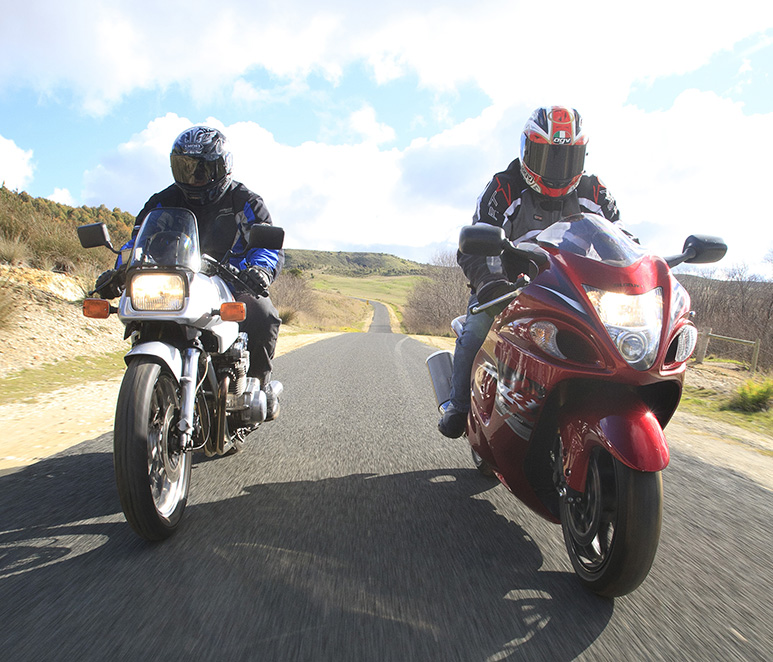
Another View
Kesting falls in lust
Landmark in motorcycle design would be one of the most often-used terms I’ve heard used to describe the mighty Katana and, yes, it’s very hard not to agree.
Even once you take the nostalgia and hype out of the equation I was finding it hard not to just want to go out and find a way to get one of these fine machines for myself.
Unlike most modern bikes that in reality can do nearly everything better, 30 years have been extremely kind to the big Suzuki and it’s the character of the thing that leaves the lasting impression.
Late-model bikes all seem to be well-built and reliable to ride and own, but not many of the latest and greatest ooze character.
Once in the saddle, first impressions were that it is a narrow bike with a fair stretch to the bars, a bit like an old Duke. Fire up the glorious old style air-cooled engine and immediately you were greeted with a quiet yet powerful sound and feel.
A great bottom end awaits with the twist of the wrist and once again another great Suzuki clutch and gearbox make light work of getting away cleanly. On the move it felt unburstable.
The suspension was a little firm and the brakes a little wooden in feel, but they were up to the task and were most likely a revelation in 1981.
I normally only reserve such adulation for old Italian bikes from Bologna, but this is an old Jap bike is easy to like and would not be hard to add to the shed.
As for the Hayabusa, bird of prey probably sums up this scorching motorcycle pretty well. The thing is up till that ride I had never really given this model much thought. Even after all the hype about the outright speed, I just could never warm to the look of the thing.
What did your Dad tell you? Something along the lines of never judge a book by its cover?
Over the course of the day spent riding across an interesting cross section of roads, ranging from awesome to absolute crap, I can honestly say there was nothing the big Suzuki couldn’t do well.
The fit and finish were quite exceptional, with that certain quality feel that in all honesty most late model Japanese bikes do possess.
So why was I so impressed? Real world performance is the best way to describe what was going on while riding. The easy-to-use riding position, superb brakes and suspension all left you feeling pretty impressed with its great composure over the vast variety of roads we encountered.
Confidence inspiring is the best way to describe it, even though there is plenty there to bite you bad if it goes pear shaped, but I somehow doubt that would be the Hayabusa’s fault.
Paul Kesting
***
More resources
See the story on our gen 1 Hayabusa
See the 1999 road test from Classic Two Wheels
***
Spex
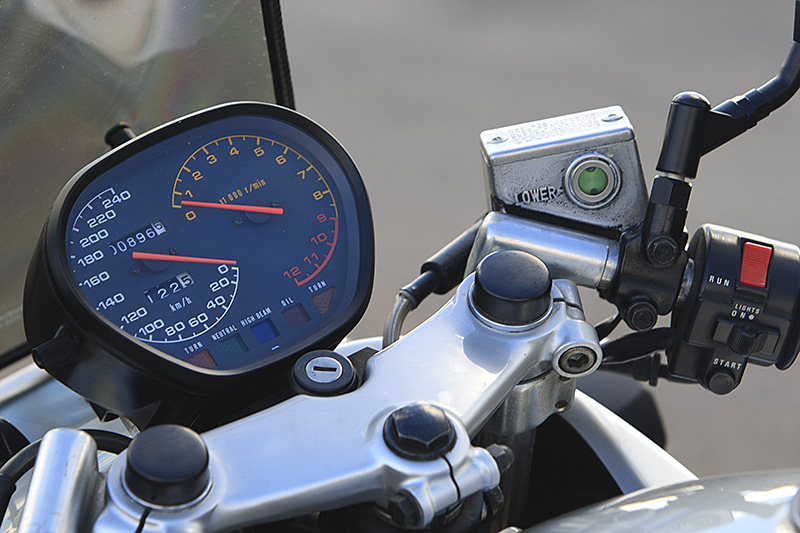
Suzuki GSX1100 Katana
ENGINE
Type: air-cooled in-line four with four valves per cylinder
Bore and Stroke: 72 x 66mm
Displacement: 1074cc
Compression ratio: 9.5:1
Fuel system: CV carburettor
TRANSMISSION
Type: 5-speed constant mesh
Final drive: Chain
CHASSIS & RUNNING GEAR
Frame type: Twin-loop steel
Front suspension: Conventional fork, preload and compression damping adjustment
Rear suspension: Twin shock, preload and compression damping adjustment
Front brakes: 2 x 275mm discs with single-piston calipers
Rear brake: 275mm disc with single-piston caliper
DIMENSIONS & CAPACITIES
Dry weight: 232kg
Seat height: 775mm
Fuel capacity: 22lt
PERFORMANCE
Max power: 111hp @9500rpm
Max torque: 97.1Nm @ 6500rpm
Max speed 230km/h
OTHER STUFF
Price when new: $3900
Good
Stylish
Lots of performance
Character
Not so good
A little clumsy
Can be uncomfortable
Is it a real SXZ?
For the Australian market ‘plain’ GSX1100 and 'race' SXZ (E24) were differentiated only by whether they had cast or wire-spoke wheels. If you’re in the market, here are the chassis numbers to look for, to ensure it’s a real SXZ: GS110X-100388 to GS110X-101324.
Other markets, such as South Africa and New Zealand got a variant dubbed the E27, which had different carburettors, cams, mufflers and front brakes. New Zealand received 20 units and South Africa 25.
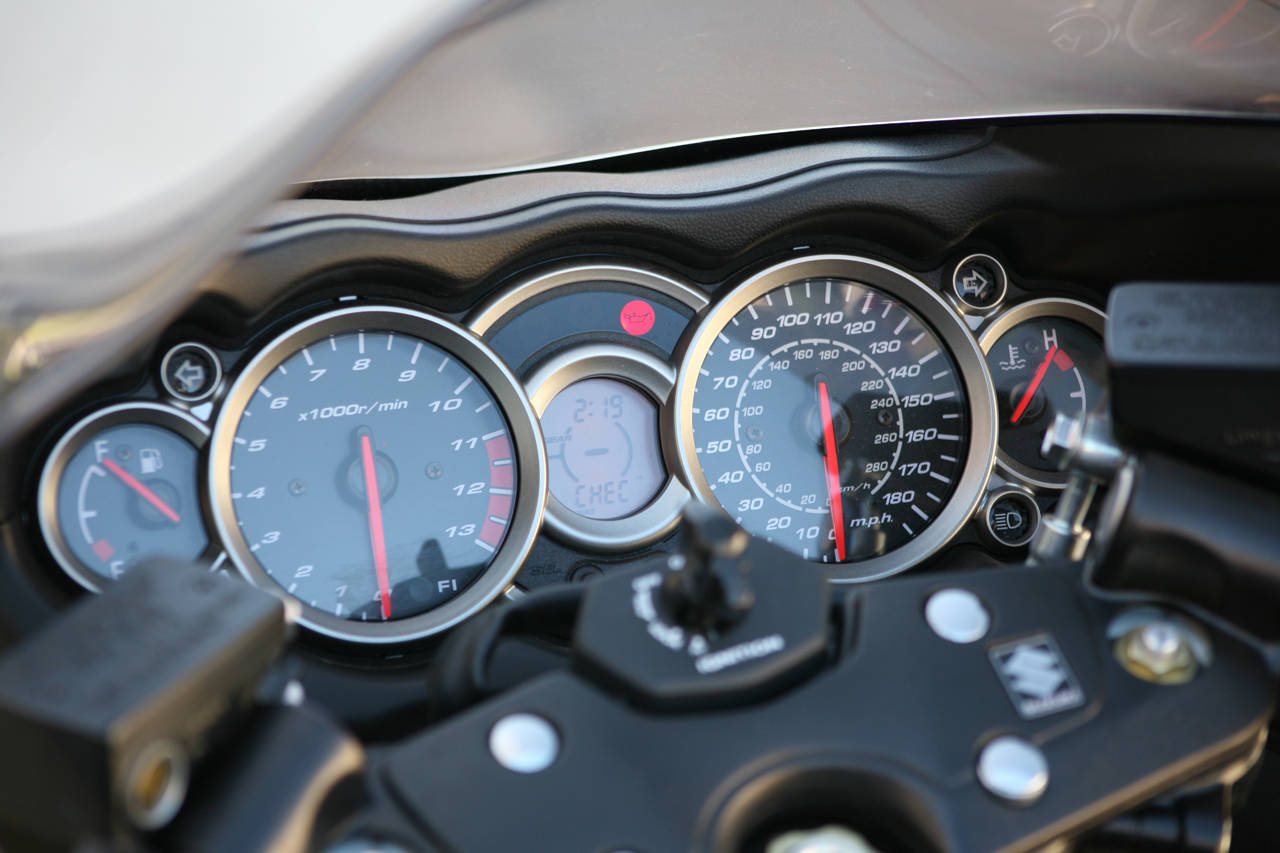
Suzuki GSX1300R Hayabusa gen 2
ENGINE
Type: Liquid-cooled in-line four with four valves per cylinder
Bore and Stroke: 81 x 65mm
Displacement: 1340cc
Compression ratio: 12.5:1
Fuel system: Electronic injection
TRANSMISSION
Type: 6-speed constant mesh
Final drive: Chain
CHASSIS & RUNNING GEAR
Frame type: Twin-spar alloy
Front suspension: USD 49mm Kayaba fork, full adjustment
Rear suspension: Monoshock, full adjustment
Front brakes: 4-piston 310mm Tokico twin discs
Rear brake: 2-piston single disc
DIMENSIONS & CAPACITIES
Dry weight: 220kg
Seat height: 805mm
Fuel capacity: 21lt
PERFORMANCE
Max power: 194hp @ 10,100rpm
Max torque: 133Nm @ 7600rpm
Max speed: Limited to 290km/h
OTHER STUFF
Price when new: $18,990 plus ORC
Good
Huge performance
Easy to ride
Well finished
Not so good
Not a scalpel-like sports bike
-------------------------------------------------
Produced by AllMoto abn 61 400 694 722
Privacy: we do not collect cookies or any other data.

Archives
Contact




